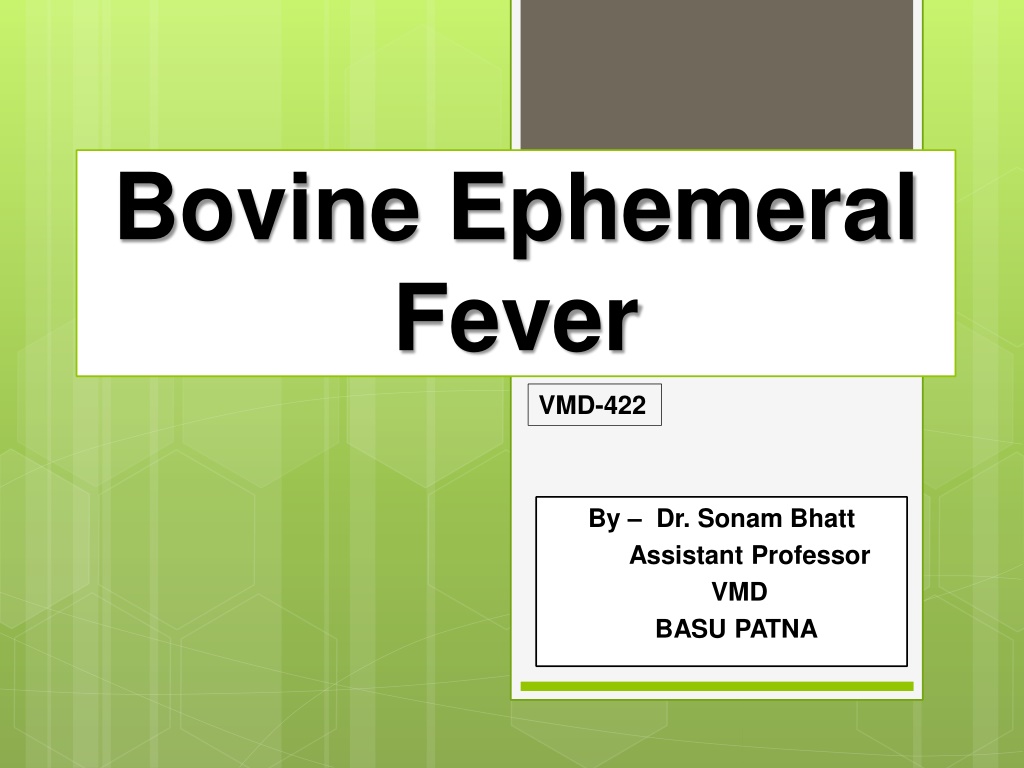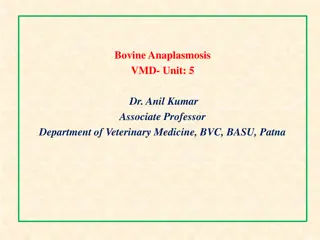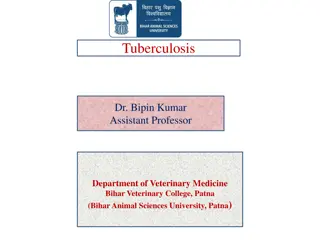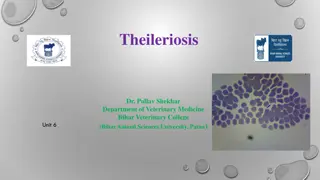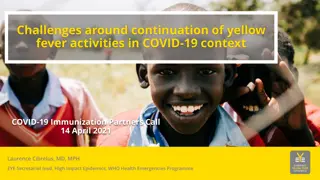Understanding Bovine Ephemeral Fever: Key Information and Insights
Bovine Ephemeral Fever, also known as Three-Day Sickness or Three-Day Fever, is an economically important arboviral disease affecting cattle and water buffalo in tropical and semitropical regions. It is caused by an arthropod-borne rhabdovirus and primarily transmitted by mosquitoes and biting midges. Outbreaks are common in summer months, with clustered and short-lived occurrences. Calves under 3-6 months old are not typically affected. The disease manifests with biphasic fever, respiratory distress, muscle trembling, limb stiffness, and pain. Pathogenesis involves vascular system multiplication, altered cellular biology, and inflammation leading to clinical signs.
Download Presentation

Please find below an Image/Link to download the presentation.
The content on the website is provided AS IS for your information and personal use only. It may not be sold, licensed, or shared on other websites without obtaining consent from the author. Download presentation by click this link. If you encounter any issues during the download, it is possible that the publisher has removed the file from their server.
E N D
Presentation Transcript
Bovine Ephemeral Fever VMD-422 By Dr. Sonam Bhatt Assistant Professor VMD BASU PATNA
Synonyms Bovine Epizootic Fever Three-Day Sickness Three Day Fever Three-Day Stiff sickness Dragon Boat Disease
Introduction Economically important arboviral disease Affects cattle and water buffalo Widespread in tropical and semitropical areas of the Eastern Hemisphere
Etiology Arthropod-borne rhabdovirus ------type species of the genus Ephemerovirus
Epidemiology Occurrence: Enzootic in the tropical areas of Africa, in most of Asia, the Middle East, the East Indies, & in much of Australia, with extensions into the subtropics & some temperate regions Source of Infection: Affected animal & biological vectors (hematophagous biting insects) Method of Transmission: Transmitted by arthropods; genera of mosquitoes, & from a number of Culicoides species (biting midges); Windborne transmission
Summer months Environment Risk Factors outbreaks are clustered & relatively short lived Only cattle are known to be naturally affected All age groups of cattle are susceptible Animal Risk Factors Calves less than 3 to 6 months old are not affected by the natural disease
Pathogenesis Virus multiplication probably occurs primarily within the vascular system Virus alters cellular biology in cattle to enhance virus entry and replication After an incubation period of 2 to 10 days, there is a biphasic fever with peaks 12 to 24 hours apart Fever lasts 2 days, and increased respiratory rate, dyspnea, muscle trembling, limb stiffness, & pain are characteristic at this time
There is generalized inflammation with vasculitis and thrombosis, serofibrinous inflammation in serous & synovial cavities, and increased endothelial permeability at the same sites Virus can be detected in circulating neutrophils and plasma, the serosal & synovial fluids Mesothelial cells of synovial membrane & epicardium, & in neutrophils in the fluids Clinical signs are thought caused by the expression of mediators of inflammation coupled with a secondary hypocalcemia
Clinical signs Calves are least affected, with those less than 3 to 6 months of age showing no clinical signs Overweight cows, high-producing cows, & bulls are affected the most In most cases, the disease is acute. After an incubation period of 2 to 4 days, sometimes as long as 10 days, there is a sudden onset of fever (40.5 41 C [105 106 F]), which may be biphasic or have morning remissions Anorexia and a sharp fall in milk yield occur
.There is severe constipation in some animals & diarrhea in others Respiratory & cardiac rates are increased, and stringy nasal & watery ocular discharges are evident Animals shake their heads constantly, and muscle shivering & weakness are observed Muscular signs become more evident on the second day, with severe stiffness, clonic muscle movements, and weakness in one or more limbs
A posture similar to that of acute laminitis, with all four feet bunched under the body, is often adopted On about the third day, the animal begins eating and ruminating, and the febrile reaction disappears, but lameness and weakness may persist for 2 to 3 more days A common name of 3-day sickness is applied because animals typically progress through onset of disease to severe illness & recovery within 3 days
Some animals remain standing during the acute stages, but the majority go down and assume a position reminiscent of parturient paresis, associated with hypocalcemia, with the hindlegs sticking out and the head turned into the flank.
Clinical pathology Marked leukocytosis with a relative increase in neutrophils occurs during the acute stage of the disease Plasma fibrinogen levels are elevated for about 7 days, and there is a marked increase in creatine kinase activity Hypocalcemia Available serologic tests include a complement fixation test, serum neutralization, fluorescent antibody test, agar gel immunodiffusion (AGID) test, & a blocking ELISA, which is reported to be simple & the preferred test
Available serologic tests include a complement fixation test, serum neutralization, fluorescent antibody test, agar gel immunodiffusion (AGID) test, and a blocking ELISA, which is reported to be simple and the preferred test
Necropsy findings Serofibrinous polyserositis Pulmonary emphysema & fibrinous bronchiolitis are standard findings, & subcutaneous emphysema along the dorsum may be observed Characteristic microscopic findings consist of a mild vasculitis of small vessels, with perivascular neutrophils & edema fluid plus intravascular fibrin thrombi
Differential diagnosis Botulism Parturient paresis Pneumonia Traumatic reticulitis
Treatment Palliative treatment with nonsteroidal antiinflammatory drugs such as IV or IM flunixin meglumine (2.2 mg/kg/d), or IM ketoprofen (3 mg/kg/d) Parenteral treatment with calcium borogluconate should be given to cows that show signs of hypocalcemia
Control Restriction of movement from infected areas is practiced, but vaccination is the only effective method of control Vaccines prepared from attenuated tissue culture virus or in mouse brain and adjuvanted in Freund s incomplete or Quil A adjuvants are commercially available in Australia, Japan, Taiwan, and South Africa Two vaccinations are required and are effective in preventing disease in natural outbreaks for periods up to 12 months
